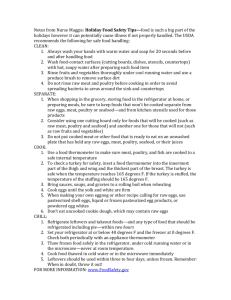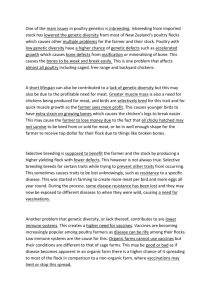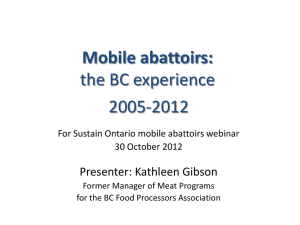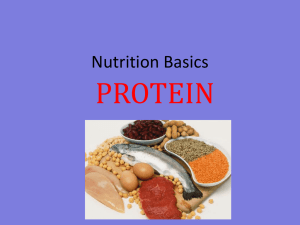Meat Sales at Farmers` Markets - Kentucky Department of Agriculture
advertisement
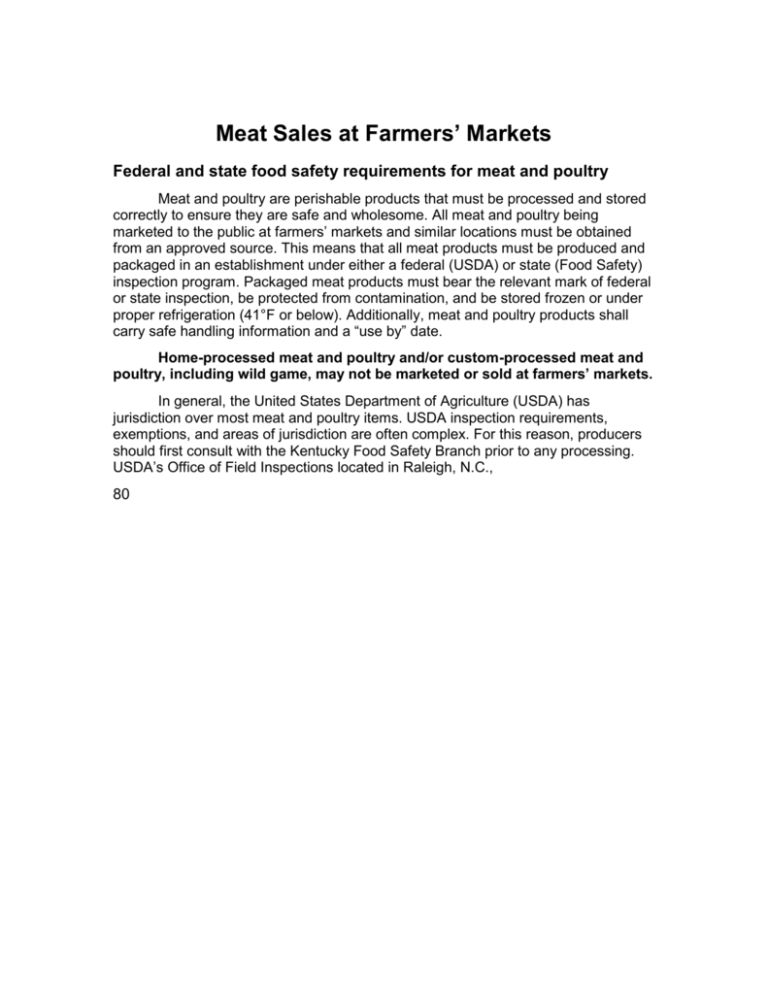
Meat Sales at Farmers’ Markets Federal and state food safety requirements for meat and poultry Meat and poultry are perishable products that must be processed and stored correctly to ensure they are safe and wholesome. All meat and poultry being marketed to the public at farmers’ markets and similar locations must be obtained from an approved source. This means that all meat products must be produced and packaged in an establishment under either a federal (USDA) or state (Food Safety) inspection program. Packaged meat products must bear the relevant mark of federal or state inspection, be protected from contamination, and be stored frozen or under proper refrigeration (41°F or below). Additionally, meat and poultry products shall carry safe handling information and a “use by” date. Home-processed meat and poultry and/or custom-processed meat and poultry, including wild game, may not be marketed or sold at farmers’ markets. In general, the United States Department of Agriculture (USDA) has jurisdiction over most meat and poultry items. USDA inspection requirements, exemptions, and areas of jurisdiction are often complex. For this reason, producers should first consult with the Kentucky Food Safety Branch prior to any processing. USDA’s Office of Field Inspections located in Raleigh, N.C., 80 telephone (919) 844-8400, is the point of contact for Kentucky farmers who are interested in obtaining a “Grant of Federal Inspection” for the processing of USDA-regulated meat and poultry products. This office should also be able to provide you with a listing of USDA-inspected processing plants in Kentucky. Cuts of meat (including beef, pork, goat, etc.) and poultry (including turkey, chicken, duck, etc.) from species which are considered amenable by United States Department of Agriculture (USDA) must be processed in a USDA-inspected facility and bear the mark of USDA inspection. Although USDA has some exemptions for small poultry processors who raise, slaughter, and sell their own product, the Kentucky Food Safety Branch still requires USDA-exempt processors to comply with state requirements for non-USDA inspected products if the products are intended to be marketed to restaurants or grocery stores or at farmers’ markets. Other animal species, such as rabbit or quail, are considered non-amenable by USDA. This means that USDA requires a fee-for-service in order to inspect the product and provide the USDA mark of inspection. A vendor who wishes to process and market cuts from non-amenable species must ensure that: (1) the products were processed under USDA inspection protocols and bear the mark of USDA inspection; or (2) the products were processed in a permitted, state-inspected and approved facility. Vendors who market product under option number two (2) above shall carry to the farmers’ market pertinent documentation — including invoices and a copy of the processing facility’s state permit — and be ready to provide this information upon request. The Mobile Processing Unit (MPU) operated by Kentucky State University is an example of a small USDA-exempt poultry processing facility that is under a state permit to operate. Poultry products processed in this state-inspected facility do not receive the mark of USDA inspection but are considered “approved-source” products. It is important that vendors who market poultry products processed in this unit at farmers’ markets be able to provide pertinent documentation (invoices, etc.) to health authorities which verify that the products are from an approved source. Inspectional jurisdiction over seafood, including fish and prawn, is retained by the Food and Drug Administration (FDA) and the agency’s state counterpart, in this case the Kentucky Food Safety Branch. All processed seafood marketed at farmers’ markets must come from a permitted, state-inspected and approved facility. Vendors shall carry to the farmers’ market pertinent documentation which can be used to verify that the product was obtained from an approved source. As addressed above, such documentation includes invoices as well as a copy of the processing facility’s state permit. Vendors selling meat, poultry, seafood and other commercially processed foods should contact their local health department with regard to obtaining a mobile, prepackaged retail sales permit. The yearly permit is 81 inexpensive ($27) and allows you to sell other commercially processed products as well as meat and poultry. The permit expires annually on December 31. Until you are ready to transport your meat and poultry products to the market, they must be stored in an approved manner, at safe refrigerated or frozen storage temperatures. If products are stored at home, they must be stored in a dedicated refrigerator or freezer, separate from personal use foods. Products must be stored at 0 degrees Fahrenheit, if frozen, or 41 degrees Fahrenheit (or colder) if refrigerated. The product must be transported and maintained at these temperatures at the market. This can be accomplished by either a freezer or an ice chest/cooler. All units holding frozen or refrigerated product should contain a thermometer in order to monitor the temperature of the product at all times. While a freezer is generally preferred, a heavy duty ice chest/cooler may also be used provided sufficient ice is available to maintain safe product temperatures. Styrofoam coolers are not approved. If you use an ice chest, the meat must be covered in the ice. You will also need to have provisions for melted ice to drain away from the product. The meat should NEVER be sitting or floating in ice water. Additionally, vendors should ensure that juices from one species (i.e., chicken) do not drip onto and contaminate another species (beef). Storing product in dedicated species-specific coolers or freezers is typically required in order to reduce the risk of cross-contamination from one species to another. At the market you have to use a tent or large umbrella so the product is covered. At all times the product should be protected from human and environmental contamination, including insects and dust. Most activities involving the handling of meat and poultry, including packaged product, can cause your hands to become soiled. Consequently, the health department will typically require that each vendor provide a suitable portable hand wash station. A simple, health departmentapproved set up could consist of an elevated 5-gallon container of potable water that is equipped with a turn-spout dispenser or drain, with a catch bucket placed below the container. Liquid soap and disposable towels should also be provided at the handwash station. Risk All producers should consider the added risk of selling retail. The potential for loss could be great. Consult your insurance professional to discuss product liability insurance. You may also consider legally organizing the meat sales part of your farm business separately to protect your farm. 82 Displays and marketing tips Meat is hard to display while maintaining correct temperature and storage requirements. Customers are accustomed to looking through meat packages to choose the one with right marbling, size, thickness, etc. that they want. Good displays of most products at a farmers’ market start with techniques that let the customer see and choose their selections. Meat in a freezer doesn’t allow for such merchandizing. Therefore, you have to give your customers something else to draw them to your booth and select your product. First, put a lot of effort into your signs. Describe your product to the customer. Tell them how thick the steaks are cut, describe the marbling, etc. Tell them why your product is different. If it is raised by your family on a nearby farm – tell them. Better yet, take photos of your farm and your family busy at work, blow those up to poster size and put them up on your booth. If your product is grass fed, pasture raised, organic, etc.– tell them, but also tell them why that is important to you and why it is important to them. Clearly display prices. If your chicken is $3 per pound and most chickens weigh between 4-5 pounds, explain this. If ground beef is packaged in 2-pound packs, make this clear. Recipes are important. Give a woman the answer to what she is cooking for dinner that night and she will be a steady customer. Offer “goes with” ideas as well to complete the meal. Feature seasonal fruits and vegetables as your “goes with” suggestions. Ask your fellow market members what recipes they have and use those. Cooperatively sell the makings for an entire meal with fellow vendors. Many folks don’t know how to cut up a chicken. If you are selling whole chickens you should get a printed guide to doing this and pass out copies. Another angle is to supply recipes for roasting or grilling whole chickens. Make sure you have the meat arranged in the ice chest or freezer to facilitate getting to a certain cut to limit the time you spend in the container. This will help you maintain the correct temperature. Vacuum packed product will get air leaks in the package if pushed around too often. Also, it is nice to reach in and get a couple of packages for the customer to choose between. Always carry business cards and price lists with you to the market. You will make a lot of contacts at the market that may result in sales from your farm. Make it easy for them to reach you or pass your name along to others. Cuts Some producers report that only their higher end cuts sell. Some report success from offering package deals on their product that include the cuts that are slow sellers. 83 Price There are essentially two types of farmers’ markets. There are price markets and specialty markets. At a price market, usually in smaller towns and rural areas away from urban areas, meat sales at a profit will be difficult. Customers are looking for a bargain. This type of market typically sets their prices to beat a large retailer like Wal-Mart. Except for a few customers, most will not spend more than what they can get the meat for at the local grocery store. If you can produce for this price and make a decent profit then it may be a good market for you. Customers at these markets may still want to buy an entire or half beef if they perceive this as a cost savings. The other markets, the specialty markets, bring higher prices. They are usually in larger urban areas or in small bedroom communities that surround urban areas where customers are seeking a certain quality of product. In these markets a producer will get higher prices for higher quality or niche products. They are usually the markets where there will be the most competition as well. Though these generalizations do not hold true in every market, it is worthwhile for a producer to investigate the strength of the potential marketplace as part of his or her decision to offer retail meat sales.

